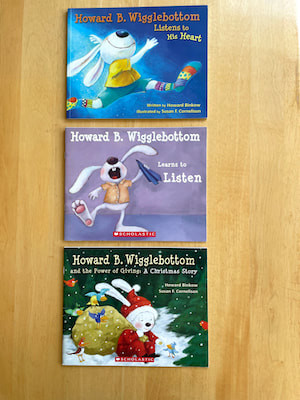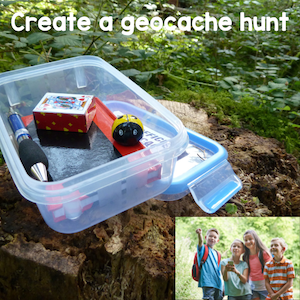|
Story books have a special way of capturing our children's imaginations and teaching them important life lessons. They can help our kids understand and care about other people's feelings, appreciate diversity, and feel good about themselves. In fact, story books can be powerful tools for helping children develop empathy, learn acceptance, and build confidence. Special Story Books For Developing Empathy, Acceptance, and Self ConfidenceOne of the great things about story books is how they make us feel. When children read stories, they connect with the characters and start to understand their own emotions better. This connection helps them show kindness and understanding towards others. Here are some of my collection that I used every year to help build a positive classroom environment. Each of these books tackles important themes such as self-acceptance, embracing individuality, standing up against bullying, and navigating cultural differences. They provide opportunities for discussions about empathy, understanding, and inclusivity, encouraging children to appreciate diversity and embrace their own unique qualities. Books About Anxiety And Self AcceptanceIn "A Bad Case of Stripes" by David Shannon., Camilla Cream loves lima beans but she is afraid of what others will think. She develops a strange case of stripes that changes with her emotions. Through this colorful and imaginative tale, the book addresses themes of self-acceptance, embracing one's true identity, and overcoming the fear of judgment. In "Woolbur" by Leslie Helakoski, Woolbur, a free-spirited sheep dares to be different. Woolbur's unique personality and refusal to conform to the flock's expectations inspire children to embrace their creativity, think independently, and celebrate their own quirks. The book encourages kids to express themselves authentically and embrace their individuality. In "Wemberly Worried" by Kevin Henkes, Wemberly worries about everything. This is a heartwarming and reassuring story that teaches children important lessons about managing their worries and finding comfort in relationships with others. Books About Problem Solving And Considering Other PerspectivesStory books also provide opportunities for problem-solving. Through the characters' challenges and dilemmas, children learn to think critically, consider different perspectives, and make choices that consider others' feelings. Howard B. Wigglebottom is a beloved character in a series of children's books by Howard Binkow. Howard is a young rabbit who encounters various situations and learns important life lessons throughout the series. Here are some of the lessons that Howard B. Wigglebottom has learned: In "Howard B. Wigglebottom Learns to Listen," Howard discovers the value of active listening. He realizes that listening attentively to others is essential for understanding, learning, and building positive relationships. In "Howard B. Wigglebottom Listens to His Heart", Howard learns about the importance of trusting his instincts and listening to his inner voice. Through relatable situations, Howard discovers the value of following his passions, making choices based on what feels right, and being true to himself. In "Howard B. Wigglebottom and the Power of Giving", joy and fulfillment that comes from giving and helping others is emphasized. Howard discovers the positive impact of acts of kindness, sharing, and generosity, teaching children the value of empathy and making a difference in the lives of others. These stories featuring Howard B. Wigglebottom are designed to engage young readers and provide them with valuable life lessons in an accessible and relatable manner. The character's experiences and growth inspire children to develop important social and emotional skills, promoting positive behaviors, empathy, and good character. Bucket Filling BooksHere are several different books that focus on bucket filling. Bucket filling is a concept that promotes kindness, empathy, and positive behavior. The idea behind bucket filling is that everyone has an invisible bucket that represents their emotional well-being. When we engage in acts of kindness, empathy, and encouragement, we "fill" someone's bucket, including our own, and promote a positive and caring environment. Conversely, negative actions, such as unkind words or bullying, can "dip" into someone's bucket and diminish their emotional well-being. Dealing With Teasing And BullyingStory books create a safe and imaginative space for children to explore complex emotions and social situations. They provide a platform for conversations in the classroom, where children can share their thoughts and learn from others' perspectives. "Oliver Button Is a Sissy" by Tomie dePaola, tells the story of Oliver Button, a boy who faces teasing and criticism because he enjoys activities traditionally associated with girls, such as dancing. Oliver finds strength and self-acceptance in pursuing his passion despite societal expectations, teaching children the importance of being true to oneself and embracing individuality. "The Recess Queen" by Alexis O'Neill, tackles the issue of bullying in a relatable and engaging way. It follows the story of Mean Jean, the recess queen, who dominates the playground with her intimidating behavior. When a new girl named Katie Sue arrives, she challenges Mean Jean's reign by extending kindness and friendship. The book promotes inclusivity, empathy, and the power of friendship. Books About Self WorthBy using story books in the classroom, we can engage children in meaningful ways. We can teach them to understand and care about others, accept and appreciate differences, and develop a positive sense of self. These Max Lucado books for kids are known for their engaging storytelling, vibrant illustrations, and uplifting messages. They aim to inspire children with the principles of faith, love, acceptance, and self-worth, while also fostering their spiritual growth and understanding. The books provide an opportunity for parents, caregivers, and educators to share valuable life lessons with children in an accessible and enjoyable way. Overcoming Obstacles And Cultural DiversityStory books inspire children to believe in themselves and overcome challenges. Characters who face obstacles show kids that they too have inner strength and can navigate life's ups and downs. "Angel Child Dragon Child" by Michele Maria Surat, tells the story of a young Vietnamese girl named Ut who moves to the United States and faces challenges as she adapts to a new culture and language. The book highlights Ut's resilience, the importance of family support, and the strength found in embracing one's cultural heritage while navigating new experiences. "The Name Jar" by Yangsook Cho, explores themes of identity, cultural diversity, and acceptance. It follows a young Korean girl, Unhei, who moves to the United States and contemplates changing her name to fit in. Through Unhei's journey, the book teaches children the value of embracing their heritage and appreciating the differences in others. Story books give children a chance to think about their own experiences and emotions. By reflecting on these stories, children become more aware of their own feelings, strengths, and worth. They feature characters who exhibit positive behaviors like kindness and resilience. These characters become role models for children, teaching them valuable lessons and helping them feel good about themselves. In "7 Habits For Happy Kids" by Sean Covey, children are introduced to seven essential habits that can help them develop a positive mindset, build healthy relationships, and make responsible choices. It teaches kids about setting goals, prioritizing tasks, and taking personal responsibility. The book empowers children to become proactive, confident, and happy individuals. These are just a few of many books out there that help develop a nurturing environment that fosters empathy, acceptance, and sef-esteem in children. By choosing meaningful stories, having open discussions, and encouraging empathy and self-reflection, we can help children grow into kind and confident individuals. Here is a template that will help children to share their feelings and connections to the stories that they read. Get a free copy by signing up to my newsletter. Let's continue to embrace the power of story books. Each story we read plants seeds of kindness and acceptance in our children's hearts. Together, we can nurture a generation of empathetic and accepting individuals who celebrate diversity and believe in themselves. Related PostsSometimes it can be challenging to find activities that engage kids as the school year ends or during the summer. Puzzles are fun to do and they help keep kids active and learning at the same time whether they are at school or at home. They can also be done at many different times of the year. Puzzles can be great for challenging our brainsPuzzles can be fun to solve and they challenge our brains to think. They are a great way to make connections between what we know and what we want to learn or discover. They can be big or small, intricate or simple, for groups or for individuals.They can be done indoors or outdoors depending on the type of puzzle used. Types of puzzlesThere are many different types of puzzles available. Some require following clues, other require manipulating pieces. Some can be done wherever you are, and some require moving around or going to other locations. The type of puzzle you choose will depend on who is going to be solving it, what the purpose of the puzzle is, and how much time is available for it. If you are going to other locations, method of travel may also need to be factored in. Here are some examples of different types of puzzle: • puzzle hunt with encrypted codes • following a timeline or identifying key objects or events • scavenger clues hunt • team puzzle hunt (In class or with other classes) • unpublished geocache Puzzle hunt with encrypted codesThis can be done in many ways. One of the simplest is to find different signs in an area and find the hidden word on each sign to lead you to the answer. I recently did one of these with a group of students. It was done with smartphones, but it doesn't have to be that sophisticated. Pen and paper can work just as well. We moved around a park that had rocks with quotes on them. We needed to figure out the codes by counting lines and letters on each rock. The kids were broken up into groups of 4 and they were given a time limit to complete the challenge. Solving math equations or answering questions to find the codes could be added for a more difficult form of puzzle hunt. Following a timeline or identifying key objects or events (like in a local museum)Following a timeline or identifying key objects or events (like in a local museum) This could be as simple as going through an exhibit and putting events in the correct order, or answering questions about different objects located there. Questions or clues could be prepared ahead of time, and on a field trip to the museum they could be used as a tool for gathering information to be discussed as a follow up to the trip. Create a scavenger clue huntCreate a scavenger hunt for home or for the classroom that requires finding different clues for the final reward. Here is a sample from one that my granddaughter and I made for her younger brother and sister. I have created a free template for you so you can make up your own scavenger hunt. Team puzzle huntThe class can be divided into groups of 4 and create riddles or clues for objects in the room and then have other groups hunt for the object. This could also be expanded to objects in the school as a whole and other classes could be invited to participate in solving the puzzles. Unpublished geocacheUsing coordinates in the school vicinity, or a neighboring park or forested area, plan a geocaching adventure for your students. You can either hide more than one geocache and give different coordinates to each group of students, or you could create a multi-cache where they must find information to move on to the next location until they arrive at the final cache. If you make it an unpublished geocache, you can remove it afterwards and you won't need to ensure that it is far enough from other published geocaches. Puzzles can be lots of fun, but they are also great ways to get outdoors and use critical thinking skills. Related PostsTeachers are looking forward to relaxing during the summer break and taking a rest from all the stress of teaching, but many are still on the lookout for ideas and inspiration for the next year. The trick is to find the balance between resting and planning as they strive to recharge for the new year. Do you like to plan first or later?Some teachers like to have a plan in place before they go on break so that they have a sense of where to start and what they want to do when it is time to return to the new school year. Other teachers like to stop completely, take a mind break, and resume their planning near the end of the summer. Both plans can work, but it is important to do what is best for you. Don't feel you have to do what your colleagues are doing. If you need the mental break now, take it. If you need to feel like you have a future plan in place, create it. Once you have done what you need to do for you, take that break and relax, refresh, and recharge. Easier said than doneIn my experience, shutting off the teacher brain at the end of the school year takes time. Although the calendar says that school is over for the year, sleeping in, formulating plans, and letting go doesn't start the next day. It takes a few days, or maybe even weeks, to really let it go and relax. When you finally start relaxing and feeling like you are on holidays, the hype for back to school starts all around you. Ads on tv, in newspapers, and on radio broadcasts begin to bombard you and you start to turn on the teacher brain again. As tempting as it may be to start doing extensive planning when this happens, it is important to still take time for you. You will burn out faster if you don't find some time to do other things and truly refresh, recharge and re-energize. One way to combine planning and fun is to do things with your children or grandchildren. You will get to see their reactions and listen to their questions as you go places and explore different events or activities together. This can provide great inspiration and creative thought for implementation of similar experiences in the classroom, because you actually got to experience them instead of just doing research for them. Today's RealityToday's reality in many school districts, at least here in Canada, is that the classes can be shuffled after the start of the year and teachers could have a totally different group or grade level than they expected. This happened to me a few years ago. I had planned a big social studies unit for my kids based on the grade I was given. I knew many of the kids and I was confident they would be able to handle the work. I even had my bulletin boards all ready and I was making resources for my lessons. A couple of days before school started, the classes were shuffled due to numbers and class sizes. I ended up going down a grade level and all the work I had done was unusable because it was too hard for younger students to handle. I took down my displays, and decided at the point I was never again going to do intensive planning ahead of time. Suggestion: If you must do some planning, do some basic planning that can support learning the first couple of weeks of school as you get to meet your students and see what will work for them. Have a wonderful break!Different parts of the world have their summer break at different times, so you may be part way through your break and in relax mode while others are anxiously waiting for their break to get here. Wherever you are on the timeline, have a wonderful and refreshing summer break. You deserve it! Remember: Relax, Refresh, Recharge. Related PostsDuring summer break, how can we ensure that kids have fun, but still keep practicing their skills so they don't become victims of the summer slide? They are ready to play and forget about school for awhile, but it is still important to maintain learning. What is the summer slide?Summer slide is a real thing and it can create a wide range of learning challenges at the beginning of the year if it isn't addressed. Summer slide is the drop in academic levels after a couple of months of inactivity with skills and concepts studied during the year. It can mean more intensive review and relearning may be needed when school resumes if it is allowed to happen. Many families don't think much about maintaining learning activities during the summer. This is not a criticism, but rather an observation. Kids are done with school by the end of the year and they are not eager to continue doing academic work during the summer holidays. Families use the time for vacations, if they are not working, or they are looking for ways to provide daycare for the kids. When they are together, they want to do things that are fun and they don't always see ways to combine the fun with academic practice. Summer school with a twistIn our district, we have summer school for the first month of the summer break. This is not your typical summer school where kids just do academic work, but rather it is a mix of academics and other activities that make learning more fun and connected. It is broken down into 2 week sets and parents can sign kids up for one or two sets. The variety of courses may combine science and art, reading and sports, writing and acting, math and science, STEM, or other combinations of academics and the arts or sports. More ways to link fun and academicsDay camps are another way of getting outdoors, having fun, and hopefully applying some skills learned to practical situations. They may include field trips to different places, art activities, sports, or other games and activities. Tapping into these and reinforcing skills linked to the practical activities is also another way of continuing to use skills and concepts taught at school. Many libraries have programs that happen in the summer. Perhaps kids could be signed up for these. Signing out books to read and participating in puppet shows, or other reading related activities is sure to help keep them engaged and reading throughout the summer. Keeping a journal or diary of vacation adventures or weekly happenings is a great way to encourage writing and also helps with remembering all the things that were done throughout the summer. Sometimes kids will be amazed at how much they did when they look back at their journal. Creating a memory book with photos and drawings is another way of capturing moments for the future. Create some games or ways of keeping track of the different activities so that they are fun to do, but they help kids to keep learning and practicing skills throughout the summer. Grab this sport themed game board to create a variety of different games that can help. Teachers can provide materials and suggestions, but ultimately, the families have to buy into the idea that maintaining skills throughout the summer is important if the summer slide is to be avoided. Check out the related posts below for some specific ideas for the various subject areas. Related Posts |
About Me Charlene Sequeira
I am a wife, mother of 4, grandmother of 9, and a retired primary and music teacher. I love working with kids and continue to volunteer at school and teach ukulele. Categories
All
|


























































 RSS Feed
RSS Feed